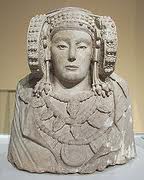Spanish Sculpture Background
There have been many Spanish sculptors over the centuries who have produced a range of sculptures for every purpose. Some Spanish sculptors invested their time in producing statues of some of the most important religious themes in Spanish culture such as the birth of Christ to his crucifixion, and everything in between.
Other Spanish sculptors dedicated their lives to the production of monuments in honour of other great Spaniards. You only have to come to study spanish to see the vast quantity of civil statues in towns and cities that commemorate painters, writers, generals and more. Abstract sculptures have also been a large part of the repertoire in Spanish culture. From monumental structures to imaginatively formed figures, Spanish sculptures are fantastic to behold.
However centuries before all of this, there were people on the Spanish peninsular who were creating sculptures with basic tools and simple techniques. A lot of the time, these sculptures were dedicated to Gods or religious scenes, yet other times, the sculptures were used to protect their creators and their livestock.
Pre-Roman Spanish Sculpture

The Celts in Spain produced many 'Verraco' sculptures which were large sculptures made out of granite. These often depicted animal figures and especially bulls who were considered the protectors of the other livestock. A good example of Pre-Roman Spanish sculpture in Spain is the 'Toros de Guisando' (Bulls of Guisando) in Ávila which date back to around 200 BC.
Other Pre-Roman Spanish sculptures include the celebrated stone sculptures of what are thought to be Goddesses created by the Iberian people. Two of the most famous of these surviving sculptures include the 'Dama de Elche' and the 'Dama de Baza'.
Roman Spanish Sculpture

During the Roman conquest of Spain, many sculptures that imitated the figures of Ancient Greek and Roman mythologies and Gods were created. Idols of the Gods Mercury and Hercules made from bronze and clay have been found in Spain, which now lie in various Spanish museums.
Other popular subjects for Spanish sculptors during this time were the current emperors of the Roman empire, of whom they would create busts and statues. There have also been some sarcophagi found from this period. The most well known sarcophagus of the Roman period is the one found in Husillos in Palencia which features relieves of mythological scenes and figures. The first Christian sarcophagus was discovered in Covarrubias. This sarcophagus is made of marble and has been dated back to the 3rd Century.
Early Christian Spanish Sculpture

Early Christian Spanish sculpture consisted mainly in elaborately decorated sarcophagi which depict Biblical scenes and allegorical representations. Some of the best examples of these sarcophagi include the sarcophagus of Leocadius in Tarragona and the sarcophagus in the 'Iglesia basílica de Santa Engracia' in Zaragoza.
Also from this period of Spanish sculpture, many statues of various subjects, grave stones and mosaics have survived until today. The mosaics are particularly magnificent as they are both beautifully colourful as well as technically brilliant, following the style of the early Roman period.
Romanesque Spanish Sculpture

During the 7th and 8th Centuries, there was a growth in the production of Spanish sculptures due to the influx of various foreign influences during this period. Also, rather than being able to pinpoint specific styles, it is easier to pick out variation by region. For example, in Catalonia, the influence of the nearby Toulouse school of sculpture can be seen in the Catalan sculpture of this time. In general terms however, Spanish sculpture during this period tended to be of a realistic and imitational style.
Marble became a popular material for sculpting during the Romanesque period of Spanish sculpture. Some of the best marble sculptures can be found in the Church of San Millán de la Cogolla in La Rioja which depict religious scenes, saints and angels. These sculptures date back to around the year of 1033.
